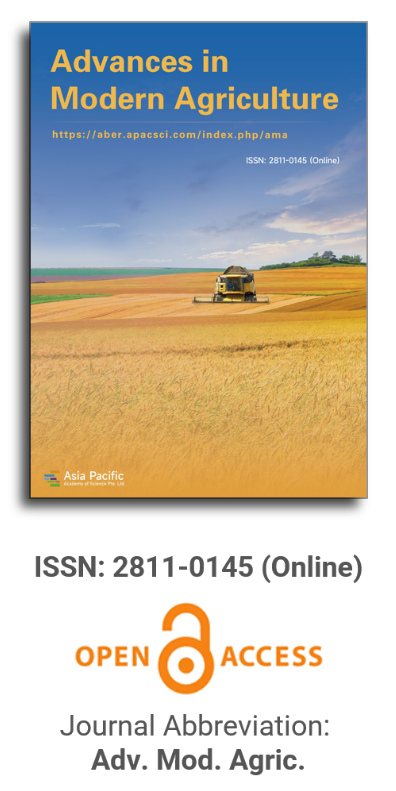


This paper analyzes the necessary linkage that must exist between the behavior of energy management in the industries destined to produce elements for agricultural productions, in this case, part of the components of irrigation systems for agriculture, important systems to ensure favorable results in the characteristic crops of each season of the year, whether or not they are short cycle. The behavior of the energetic expense is fundamentally analyzed, mainly of the electric system and the support energetic systems that determine the conformation of the productions destined for the irrigation systems. Proposals are made that can contribute to diminishing the production costs in the productive entity and that can contribute to a decrease in the cost of obtaining the agricultural product.
An oscillating slat shovel has presented a promising application potential in the energy-saving and efficient harvesting of deep rhizome crops. This new type of shovel slat integrated harvesting device was developed using gradient amplitude and gradient vibration technology. This study aims to clarify the working characteristics of oscillating slat shovels and the mechanism of throwing separation. The throwing coefficient was selected to characterize the throwing separation ability of the slat shovel work plane. A motion analysis was made to calculate the swing acceleration of the slat shovel work plane. An analytical equation of the throwing coefficient was then established to combine with the working process, the periodic variation of the throwing coefficient, and the influence of parameters, including the amplitude, vibration frequency, and working length. The results showed that the throwing coefficient gradually increased at each point of the slat shovel work plane, indicating outstanding gradient throwing characteristics and strong throwing ability. The maximum throwing coefficient was 9.98–19.72 in the separation area. After that, an investigation was made to determine the influence of the structure and working parameters of the oscillating slat shovel on the soil-throwing separation performance. The EDEM-MBD coupling simulation model of the single pendulum shovel gate was established to simplify the structural model and the interaction between the rhizome, soil, and working components, where the indicators were set as the traction resistance, driving torque, the maximum separation distance between the soil and the slat (separation distance), and the ratio of the separated soil quality of each functional area of the work-plane to the total soil mass (separation ratio). A single-factor test was carried out with the amplitude, vibration frequency, and forward speed as factors. The results indicated that: 1) There were outstanding strong-weak cycles in the traction resistance and driving torque due to the gradient throwing characteristics of the oscillating slat shovel, soil viscosity, and plasticity. In the strong period, there was a large interaction force between the shovel slat and soil, where the maximum separation distance occurred at the middle point of the separation area at the endpoint of the cutting stroke. 2) The amplitude was negatively correlated to the traction resistance but positively correlated with the driving torque and separation distance. The vibration frequency was negatively correlated to the traction resistance, driving torque, and separation spacing. The forward velocity was positively correlated to traction resistance and driving torque but negatively correlated to the separation distance. 3) There was a small influence of amplitude and vibration frequency on the separation ratio. There was a low separation of oscillating slat shovels with the increase in forward velocity. 4) A combination of parameters was achieved when the amplitude was 7–11 mm in the strong period, where the average traction resistance was about 1580.93–2019.9 N, the maximum driving torque was about 224.04–322.11 N·m, and the maximum separation distance was about 59.58–98.3 mm. 5) The average traction resistance was about 1416.43–1866.38 N, the maximum driving torque was about 315.28–364.19 N·m, and the maximum separation distance was about 78.43–94.67 mm when the vibration frequency was 6.67–10.67 Hz. 6) The average traction resistance was about 1429.43–2110.48 N, the maximum driving torque was about 241.27–387.78 N·m, and the maximum separation distance was about 62.5–102.5 mm when the forward speed was 0.2–0.4 m/s. An optimal combination of parameters was selected for the field experiment: the amplitude was 9 mm, the vibration frequency was 9.4 Hz, and the working speed was 0.32 m/s. The licorice harvesting test indicated that the traction resistance was about 32.17 kN, the driving torque was about 802.02 N·m, the excavation depth was about 468 mm, and the cleaning rate was about 96.42%. Consequently, the oscillating slat shovel harvesting device can be feasible for smooth and orderly operation as well as the higher separation performance of rhizome-soil, where all the operation indexes meet the national standards. This finding can provide a new method and design reference for the energy-saving and efficient harvesting of rhizomes, especially deep rhizome crops.
Citrus is widely planted in southern China. Due to cloudy and rainy weather, complex planting types, and other factors, it is difficult to use spectral information to directly identify citrus orchard information. Based on the unique phenological characteristics of citrus, this study put forward the hypothesis that “the vegetation information of citrus orchards may be weakened during the growth and expansion of citrus fruit”. According to this feature, a method of citrus orchard information identification is proposed, and the threshold of the key time window is determined. Taking Wuming District, Nanning City, and Guangxi Zhuang Autonomous Region as the research area, an empirical study on remote sensing identification of citrus orchard information is carried out. First, multi-temporal Sentinel-2 remote sensing images of the study area in 2018 were obtained, and a normalized difference vegetation index was constructed. NDVI, Green Normalized Difference Vegetation Index (GNDVI), Difference Vegetation Index (DVI), Sentinel-derived red-edge spectral indices (RESI), and other vegetation spectral indices Secondly, according to the ground sample point information, the difference in remote sensing vegetation information of different vegetation types in different periods was compared, and then the optimal features of citrus orchard identification were determined. The results showed that there was no significant difference in spectral characteristics between citrus orchards and other major crop types in the study area (such as sugarcane, banana, corn, rice, etc.), but the multi-temporal remote sensing vegetation index of the study area showed that the NDVI of citrus orchards in October was 0.47 lower than that of November, which was significantly lower than that of other crop types. In October, the GNDVI of the citrus orchard also showed a low value of 0.43, but the difference was not obvious compared with other months. However, the dispersion degree of citrus orchard DVI was low, and the separation was not strong. According to the crop phenological calendar, the period of rapid expansion of citrus fruits was from September to October, which verified the scientific hypothesis proposed in this study that the vegetation information of citrus orchards would be weakened during this period. The dispersion degree of different vegetation indexes in the citrus fruit expansion stage was obviously different, and the dispersion degree of NDVI was the highest, and the difference was the strongest. According to the phenological characteristics of the citrus orchard NDVI in October, to further build the normalized index, by using the threshold value method to identify the spatial distribution of the citrus orchard, the identification method had an overall accuracy of 82.75%, better than other identification results of vegetation index. The results of the study for citrus orchard information and remote sensing identification research provide better support for theory and practice.
Rhizobacteria are a vast and very diverse group of bacteria that live in the vicinity of roots. They develop beneficial, neutral, and even detrimental relationships, although the latter to a lesser extent. The interactions between bacteria and plant roots have played a determining role in the adaptation and productivity of plant species over time. Several studies show that rhizobacteria have improved plant growth, production, and health, both directly through mechanisms that include the assimilation of vital nutrients such as nitrogen fixation, phosphorus and potassium solubilization, and phytostimulation through the production of various phytohormones) and indirectly (by affecting the growth of important pathogens, activating plant immunity, and improving problems caused by abiotic stress). Due to their metabolic diversity, rhizobacteria could contribute positively to the improvement of agricultural productivity and the solution of environmental problems caused by the methods used in current agriculture. Several genera, such as Acidithiobacillus, Aminobacter, Arthrobacter, Azoarcus, Azospirillum, Azotobacter, Bacillus, Burkholderia, Clostridium, Enterobacter, Gluconoacetobacter, Pseudomonas, Serratia, and Sphingomonas, have demonstrated their enormous growth-promoting capacity. This review provides a focus on the mechanisms by which rhizobacteria enhance plant growth, their contribution to sustainable agriculture, and their commercialization, a field that continues to grow steadily.
The contribution of business marketing of genetically modified (GM) plants to crop improvement, reduced use of pesticides, and the improvement of the ecological environment was presented. The toxicity and allergy of GM food, the ecological risks confronted by GM plant cultivation, and the necessity of government inspection of GM products were also discussed. GM plants and their derived products have been consumed as food for more than 30 years since the commercialization of transgenic plants in 1995. Most scientific papers have proved that there is no significant discrepancy between GM plants and non-GM plants in composition till now. The discovery of natural transgenic sweet potatoes has further demonstrated the safety of GM foods.

Prof. Zhengjun Qiu
Zhejiang University, China

Cheng Sun
Academician of World Academy of Productivity Science; Executive Chairman, World Confederation of Productivity Science China Chapter, China
Indexing & Archiving
In the realm of modern agriculture, the integration of cutting-edge technologies is revolutionizing the way we approach sustainable farming practices. A recent study published in Advances in Modern Agriculture titled "Classification of cotton water stress using convolutional neural networks and UAV-based RGB imagery" has garnered significant attention for its innovative approach to precision irrigation management. Conducted by researchers from Institute of Data Science and the AgriLife Research and Extension Center of Texas A&M University (authors's information is below). This study introduces a novel method for classifying cotton water stress using unmanned aerial vehicles (UAVs) and convolutional neural networks (CNNs), offering a powerful solution for optimizing water use in agriculture.
Modern agricultural technology is evolving rapidly, with scientists collaborating with leading agricultural enterprises to develop intelligent management practices. These practices utilize advanced systems that provide tailored fertilization and treatment options for large-scale land management.
This journal values human initiative and intelligence, and the employment of AI technologies to write papers that replace the human mind is expressly prohibited. When there is a suspicious submission that uses AI tools to quickly piece together and generate research results, the editorial board of the journal will reject the article, and all journals under the publisher's umbrella will prohibit all authors from submitting their articles.
Readers and authors are asked to exercise caution and strictly adhere to the journal's policy regarding the usage of Artificial Intelligence Generated Content (AIGC) tools.
Asia Pacific Academy of Science Pte. Ltd. (APACSCI) specializes in international journal publishing. APACSCI adopts the open access publishing model and provides an important communication bridge for academic groups whose interest fields include engineering, technology, medicine, computer, mathematics, agriculture and forestry, and environment.


 Open Access
Open Access

.jpg)
.jpg)

.jpg)
